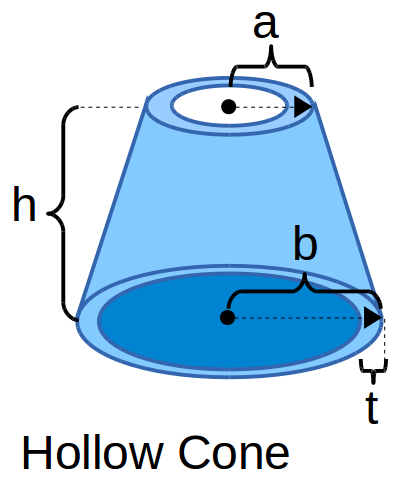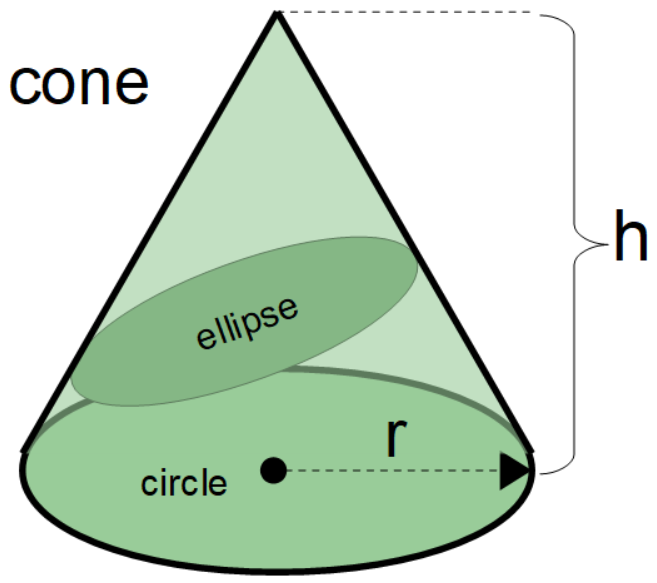Cone - Shell Volume
The Volume of the Shell of a Cone (Hollow Cone) calculator  computes the volume of the shell of a cone. The volume is a function of the top radius (a), bottom radius (b), thickness (t) and height (h) in between.
computes the volume of the shell of a cone. The volume is a function of the top radius (a), bottom radius (b), thickness (t) and height (h) in between.
INSTRUCTION: Choose your length units (e.g. inches or meters) and enter the following:
- (a) Outer Radius of Top surface
- (b) Outer Radius of Bottom surface
- (h) Height between Top and Bottom
- (t) Thickness of Shell
Cone Shell Volume (V): The calculator computes the volume in cubic meters (m3). However this can be automatically converted to many other volume units (e.g. gallons or cubic feet) via the pull-down menu. To compute the Weight of the Shell of a Cone, CLICK HERE.
The Math / Science
A frustum of a cone is created by parallel planes that go through the cone that are normal (perpendicular) to the center axis of the cone. The planes are separated by the height (h). The formula for the Volume of the Frustum of a cone is as follows:
where:
- V = volume of the cone frustum
- a = radius of the top circle
- b = radius of the bottom circle
Assuming a constant thickness in the wall of the cone shell, the formula for the volume of a cone shell is:
VCS = VO - VI
where:
- VCS = Volume of the Cone Shell
- VO = Volume of Outer Cone
- VI = Volume of the Inner Cone
- Cone Surface Area based on cone height and cone base radius
- Cone Volume based on cone height and cone base radius
- Cone Mass or Weight as a function of the volume and mean density
- Cone Frustum Surface Area based on the two heights and two radii
- Cone Frustum Volume based on the two heights and two radii
- Cone Frustum Weight or Mass based on the cone frustum volume and mean density
- Cone Shell Volume a.k.a. hollow cone volume
- Cone Shell Mass or Weight a.k.a. hollow cone mass
- Moment of inertia of a cone shaped object based on mass and rotation axis
- Moment of inertia of a cone shaped object based on mass and distance to apex (rotation around apex)
- Compute the total surface are of the frustum of a cone: This includes the top and bottom surfaces.
- Compute the lateral surface area (using L) of the frustum of a cone.
- Cone Frustum Volume from Angle
- Cone Frustum Height from Volume and Outer Side Angle: Computes height based on volume, small radius and outer side angle.
- Cone Frustum Height from Volume and Inner Side Angle: Computes height based on volume, small radius and inner side angle.
See Also
- Frustum Calculator - Equations for volume, mass and surface areas for various frustums.
- Planter Calculator - Equations for home and garden planters.
- Volume Calculator - Volume equations for various geometric shapes
- Mass Weight Calculator - Equations for the mass and weight of objects based on their mean density and shape
Volume is a three dimensional measurement of the amount of space taken up by an object. Volume units are cubic measurements for solid objects such as cubic inches and cubic meters. Fluids have separate volume units such as liters, fluid ounces, cups, gallons, and barrel.
The volume of an object can measured by the liquid it displaces or be calculated by measuring its dimensions and applying those dimensions to a formula describing its shape. Many such calculations are available in the following list of calculators.
In many cases, the calculators are for a column with a geometric shaped base and vertical sides. One basic formula for volume is area times a Height when the volume has vertical sides.

Volume Calculators
- Volume from Area and Height
- Volume of a Cube
- Volume of a Box
- Volume of a Cone
- Volume of a Cone Frustum
- Volume of a Cylinder
- Volume of a Slanted Cylinder
- Volume of a Semicircle
- Volume of a Triangular
- Volume of a Quadrilateral
- Volume of a Pentagon
- Volume of a Hexagon
- Volume of a Heptagon
- Volume of a Octagon
- Volume of a Nonagon
- Volume of a Decagon
- Volume of a Hendecagon
- Volume of a Dodecagon
- Volume of a Paraboloid
- Volume of a Polygon based Pyramid
- Volume of a Pyramid Frustum
- Volume of a Sphere
- Volume of a Sphere Cap
- Volume of a Sphere Segment
- Volume of a Sphere Shell
- Volume of a Oblate Spheroid
- Volume of a Ellipsoid
- Volume of a Torus
- Volume of a Bottle
- Volume of a Chamfer
- Gasket Volume
Reference
- Equation 4.42 Spiegel, Murray R. "Chapter 4." Mathematical Handbook of Formulas and Tables. New York: McGraw-Hill, 1968. N. pag. Print.
Calculators
Equations and Data Items
- Comments
- Attachments
- Stats
No comments |


